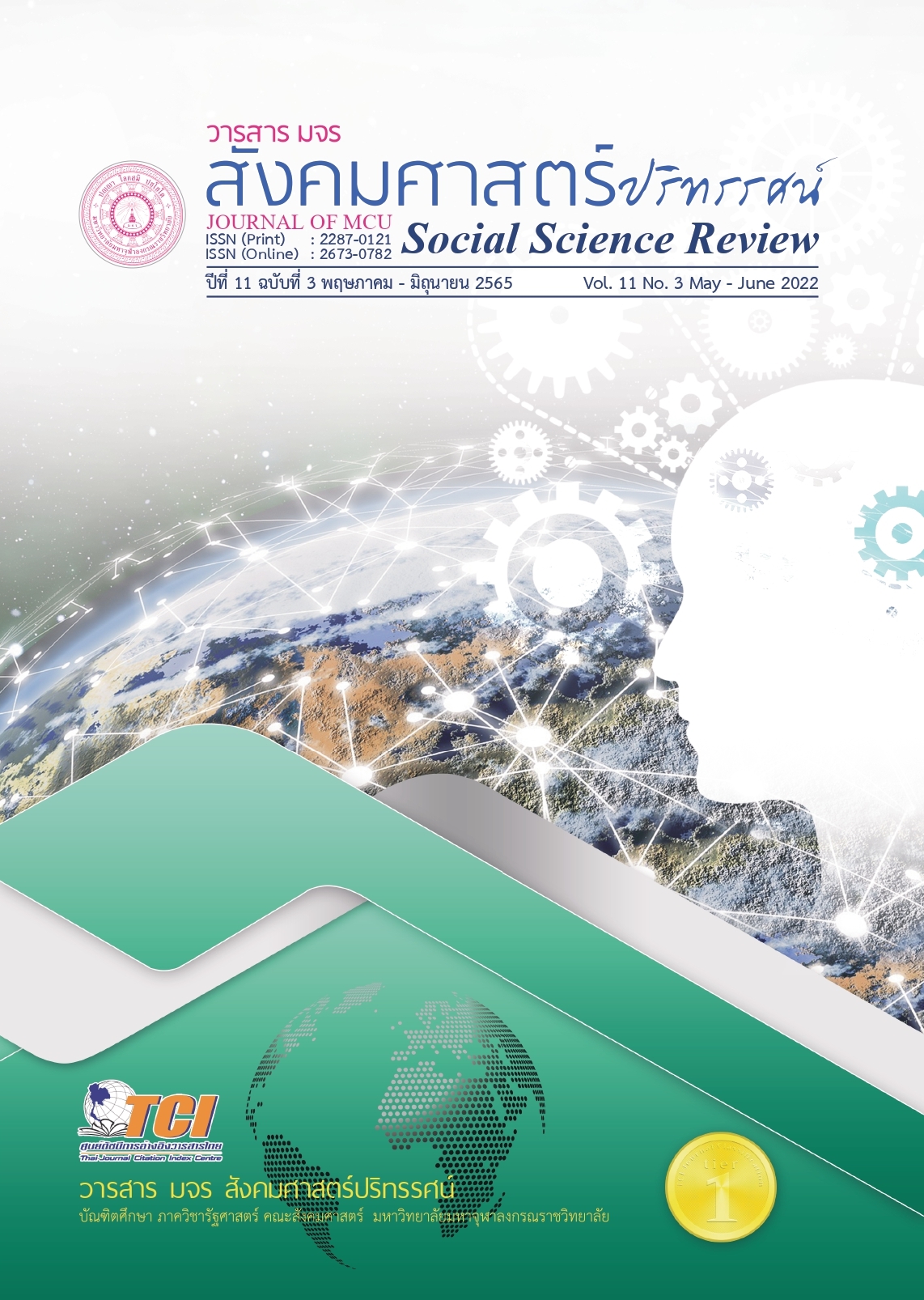รูปแบบการเลือกตั้งที่เหมาะสมกับประเทศไทย
คำสำคัญ:
รูปแบบ, การเลือกตั้ง, ประเทศไทยบทคัดย่อ
การศึกษามีวัตถุประสงค์เพื่อ 1. ศึกษาบริบทและระบบการเลือกตั้ง 2. วิเคราะห์ระบบการเลือกตั้งรัฐธรรมนูญแห่งราชอาณาจักรไทย พ.ศ.2540 พ.ศ. 2550 และ พ.ศ. 2560 และ 3. นำเสนอรูปแบบการเลือกตั้งที่เหมาะสมกับประเทศไทย ใช้วิธีวิจัยเชิงคุณภาพ ศึกษาเอกสาร สัมภาษณ์เจาะลึก จำนวน 18 คน และจัดกลุ่มสนทนา จำนวน 10 คน วิเคราะห์เชิงเนื้อหาและวิเคราะห์เชิงอุปนัย
การวิเคราะห์ พบว่า การเลือกตั้งตามรัฐธรรมนูญ พ.ศ. 2540 ข้อดีคือ การเลือกตั้งแบบระบบบัญชีรายชื่อถูกนำมาใช้เป็นครั้งแรกในประเทศไทย พรรคการเมืองมีความสำคัญมากขึ้น รัฐบาลมีความเข็มแข็งและเสถียรภาพสมาชิกวุฒิสภา ข้อเสีย การเลือกตั้งแบบระบบแบ่งเขตสมาชิกสภาผู้แทนราษฎร คือ ผู้ที่ได้รับคะแนนสูงสุดเพียงคนเดียว การเลือกตั้งตามรัฐธรรมนูญ พ.ศ. 2550 ข้อดี ประชาชนสามารถเลือก สมาชิกสภาผู้แทนราษฎร ในระบบแบ่งเขตได้มากกว่า 1 คน การแบ่งกลุ่มจังหวัดออกเป็น 8 กลุ่มในระบบบัญชีรายชื่อทำให้ ข้อเสีย ระบบแบ่งเขตทำให้แต่ละเขตได้จำนวนสมาชิกสภาผู้แทนราษฎร การเลือกตั้งตามรัฐธรรมนูญ พ.ศ.2560 ข้อดี ใช้คะแนนจากระบบแบ่งเขตมาคำนวณจำนวนสมาชิกสภาผู้แทนราษฎร ในระบบบัญชีรายชื่อ ทำให้คะแนนเสียงของประชาชนไม่สูญเปล่า ข้อเสีย ใช้บัตรเลือกตั้งเพียงใบเดียว ทำให้ผู้ลงคะแนนเสียงไม่สามารถแยกการเลือกสมาชิกสภาผู้แทนราษฎร ในระบบแบ่งเขตออกจากการเลือกพรรคการเมือง 3. รูปแบบการเลือกตั้งที่เหมาะสมกับประเทศไทย ควรเป็นระบบการเลือกตั้งที่มีหลักการคำนวณคะแนนที่มีความสัมพันธ์กันระหว่างสองระบบ
เอกสารอ้างอิง
จิรวัฒน์ ศิริพานิชย์ และคณะ. (2561). ปัจจัยเชิงสาเหตุที่ทรงอิทธิพลต่อการลงคะแนนเสียงเลือกตั้ง. วารสารสถาบันวิจัยและพัฒนา มหาวิทยาลัยราชภัฎมหาสารคาม, 5(1), 311-322.
ชงคชาญ สุวรรณมณี. (2561). การเลือกตั้งครั้งแรก ตามรัฐธรรมนูญแห่งราชอาณาจักรไทยพุทธศักราช 2560. กรุงเทพฯ: สำนักวิชาการ สำนักงานเลขาธิการสภาผู้แทนราษฎร.
ชาญวิทย์ เฟื่องฟูกิจการ. (2563). มาตราการทางกฎหมายในการเลือกตั้งสมาชิกสภาผู้แทนราษฎรระบบบัญชีราบชื่อของประเทศไทยเปรียบเทียบกับต่างประเทศ, วารสารมหาจุฬานาครทรรศน์, 7(11),235-251.
แดนชัย ไชวิเศษ. (2561). ที่มาของสมาชิกสภาผู้แทนราษฎร. กรุงเทพฯ: สำนักวิชาการสำนักงานเลขาธิการสภาผู้แทนราษฎร.
ทัดชนม์ กลิ่นชำนิ. (2562). เรียนรู้ระบบเลือกตั้งสู่บทเรียนการเลือกตั้งในรัฐธรรมนูญ 2562. กรุงเทพฯ: กองประสานงานการเมือง สำนักเลขาธิการนายกรัฐมนตรี.
ธเนศ อาภรณ์สุวรรณ. (2549). ความคิดการเมืองไพร่กระฎุมพีแห่งกรุงรัตนโกสินทร์. กรุงเทพฯ: สำนักพิมพ์มติชน.
บุญส่ง น้อยโสภณ. (2560). บทบาทของคณะกรรมการการเลือกตั้งตามรัฐธรรมนูญแห่งราชอาณาจักรไทย พุทธศักราช 2560. กรุงเทพฯ: วิทยาลัยรัฐธรรมนูญ สำนักงานศาลรัฐธรรมนูญ.
พรรณรัตน์ ดิษฐ์เจริญ และคณะ. (2563). ปัญหาระบบการเลือกตั้งสมาชิกสภาผู้แทนราษฎรแบบผสมตามรัฐธรรมนูญแห่งราชอาณาจักรไทย พุทธศักราช 2560. วารสารนิติศาสตร์ มหาวิทยาลัยนเรศวร, 13(2),169-197.
พัชรวาท วงษ์สุวรรณ. (2559). การเคารพสิทธิของเสียงข้างน้อยตามหลักประชาธิปไตย.กรุงเทพฯ: วิทยาลัยรัฐธรรมนูญ สำนักงานศาลรัฐธรรมนูญ.
รณชัย โตสมภาค. (2559). ประชาธิปไตย. กรุงเทพฯ: สำนักวิชาการ สำนักงานเลขาธิการสภาผู้แทนราษฎร.
วัฒนชัย ศิริญาณ และชัยรัตน์ มาสอน. (2561). การพัฒนาพลเมืองตามระบอบประชาธิปไตยในศตวรรษที่ 21. รมยสาร, 16(1),156-181.
สำนักงานคณะกรรมการกฤษฎีกา. (2561). กฤษฎีกา โฟกัส. กรุงเทพฯ: กองกฎหมายไทยสำนักงานคณะกรรมการกฤษฎีกา.
Plescia, C.et al. (2019). Do people want a ‘fairer’ electoral system? An experimental study in four countries. European Journal of Political Research, 59(4),733-751.
ดาวน์โหลด
เผยแพร่แล้ว
รูปแบบการอ้างอิง
ฉบับ
ประเภทบทความ
สัญญาอนุญาต
ลิขสิทธิ์ (c) 2022 วารสาร มจร สังคมศาสตร์ปริทรรศน์

อนุญาตภายใต้เงื่อนไข Creative Commons Attribution-NonCommercial-NoDerivatives 4.0 International License.
เพื่อให้เป็นไปตามกฎหมายลิขสิทธิ์ ผู้นิพนธ์ทุกท่านต้องลงลายมือชื่อในแบบฟอร์มใบมอบลิขสิทธิ์บทความให้แก่วารสารฯ พร้อมกับบทความต้นฉบับที่ได้แก้ไขครั้งสุดท้าย นอกจากนี้ ผู้นิพนธ์ทุกท่านต้องยืนยันว่าบทความต้นฉบับที่ส่งมาตีพิมพ์นั้น ได้ส่งมาตีพิมพ์เฉพาะในวารสาร มจร สังคมศาสตร์ปริทรรศน์ เพียงแห่งเดียวเท่านั้น หากมีการใช้ภาพหรือตารางหรือเนื้อหาอื่นๆ ของผู้นิพนธ์อื่นที่ปรากฏในสิ่งตีพิมพ์อื่นมาแล้ว ผู้นิพนธ์ต้องขออนุญาตเจ้าของลิขสิทธิ์ก่อน พร้อมทั้งแสดงหนังสือที่ได้รับการยินยอมต่อบรรณาธิการ ก่อนที่บทความจะได้รับการตีพิมพ์ หากไม่เป็นไปตามข้อกำหนดเบื้องต้น ทางวารสารจะถอดบทความของท่านออกโดยไม่มีข้อยกเว้นใดๆ ทั้งสิ้น





